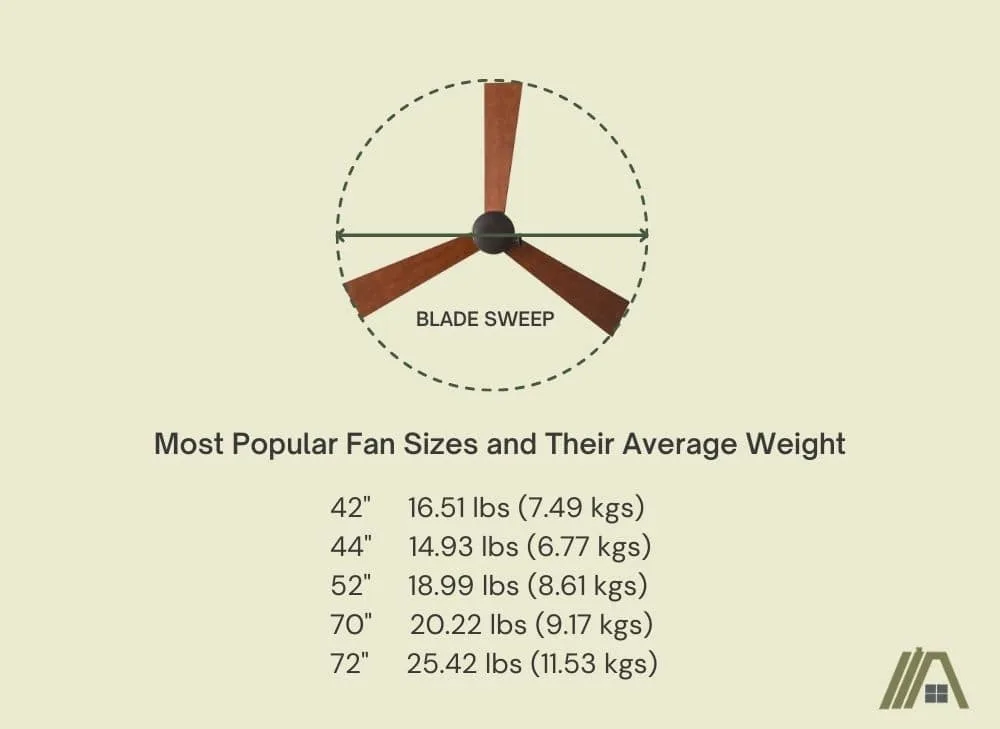When people talk about the installation of a ceiling fan, everyone talks about the electrical junction boxes and how much weight they can handle. However, we tend to kind of skim over the question of how much the actual ceiling fan weighs.
While most of us assume that this doesn’t raise any cause for concern, it is actually pretty useful (not to mention safe) to know how much your ceiling fan weighs. So, if you are curious, let’s look at how much a ceiling fan can weigh, what affects its weight, and why it is good to know!

Ceiling fans typically weigh between 12 lbs and 50 lbs. The weight depends on the fan size, materials (type and quality), number of blades, and the presence/absence of light fixtures. Knowing the weight of a fan ensures that the correct junction box is chosen, which, in turn, reduces safety risks.
How to Find out How Much a Ceiling Fan Weighs
Finding out how much your current or desired ceiling fan weighs is very straightforward.
The easiest and fastest way to do so would be to read the technical specifications written in a “Spec sheet” that came with your fan.
Or if you haven’t bought a fan yet, and are still browsing the internet for one, all you need to do is open the manufacturer’s website, find the fan you are interested in and download the pdf “Spec sheet,” which can typically be found right next to the manual.
Alternatively, for those who like to shop on Amazon, I recommend simply typing the word “weight” into the “Have a question?” window below the product that you are looking at. That way, you will save yourself the hassle of looking through the whole post description. Rather let Amazon do the job for you!
However, it is worth mentioning that you will not always be able to find the weight on Amazon.
If everything else fails, you can still contact the manufacturer. If they don’t know—then oi vey!
Factors Affecting Ceiling Fan Weight
1. The Size of the Ceiling Fan
It is pretty rare to find a one-size-fits-all product, and the situation is no different when it comes to ceiling fans. They need to come in different sizes to be able to suit different room sizes.
To be more specific, ceiling fans can have various blade spans/ blade sweeps. This is the diameter of the circle that is drawn by the fan when running. In other words, it is the width of the ceiling fan.
The blade sweep is measured from the tip of one blade to the tip of the opposite blade. Some of the most popular fan sizes are 42″, 44″, 52″, 70″, and 72″. Now, let’s see what the average weights of these sizes are.
| Average weight ceiling fans | |
| 42” | 16.51 lbs (7.49 kgs) |
| 44” | 14.93 lbs (6.77 kgs) |
| 52” | 18.99 lbs (8.61 kgs) |
| 70” | 20.22 lbs (9.17 kgs) |
| 72” | 25.42 lbs (11.53 kgs) |

2. The Material the Fan Is Made Of
The weight of the ceiling fan is affected by many factors. It is not as easy as smaller equals lighter (just look at the average weights of the 42″ and 44″ fans in the previous table), not even if the fans are made from the same material.
It comes as no surprise that the manufacturers try to use relatively light materials, such as light metals, plastic, and wood.
In fact, many ceiling fans have a metal housing combined with wooden blades. This is a very elegant and lightweight combination. On the other hand, metal blades are typically the most efficient and durable, while plastic ones are considered to be the easiest to maintain.
However, the weight differences are caused not only by the fan’s material itself but also by the exact type and quality of the materials used and the design of the fan.
If the fan has many decorative elements, they will add to its weight. Or if the fan’s blades are made out of MDF wood rather than solid wood, they will likely weigh more than, let’s say, timber blades would.
So what is the average weight of fans made from these three different materials?
| Average weight of metal ceiling fans | Average weight of wood or wood/metal ceiling fans | Average weight of plastic ceiling fans | |
| 42” | 30 lbs (13.6 kgs) | 14.05 lbs (6.37 kgs) | 15.4 lbs (6.98 kgs) |
| 44” | 17.61 lbs (7.99 kgs) | 18.9 lbs (8.57 kgs) | 12.03 lbs (5.46 kgs) |
| 52” | 20.3 lbs (9.2 kgs) | 18.4 lbs (8.35 kgs) | 20.77 lbs (9.42 kgs) |
| 70” | 28.47 lbs (12.91 kgs) | 16.28 lbs (7.38 kgs) | 32.38 lbs (14.69 kgs) |
| 72” | 31.73 lbs (14.4 kgs) | 17.2 lbs (7.8 kgs) | 26.8 lbs (12.16 kgs) |
3. Number of Blades
As you have probably guessed by now, the number of blades a fan has also significantly affects its final weight.
The more blades, the higher the weight. This is why you can see a 3-blade metal ceiling fan that is lighter than a 5-blade wood or plastic fan of the same size.
Of course, there can always be some exceptions, as you will see in the table. This happens mainly because, sometimes, ceiling fans of a certain size can all be made from the same type of material, and so their average weight is slightly lower or higher than an average weight of a selection of fans of different materials and designs.
| Average weight of fans with 3 blades | Average weight of fans with 4 blades | Average weight of fans with 5 blades | Average weight of fans with 6 blades | |
| 42” | 15.04 lbs (6.82 kgs) | 14.4 lbs (6.5 kgs) | 15 lbs (6.8 kgs) | 30.56 (13.86 kgs) |
| 44” | 12.63 lbs (5.73 kgs) | 20.8 lbs (9.4 kgs) | 17.0 lbs (7.7 kg) | 17.42 lbs (7.9 kgs) |
| 52” | 14.95 lbs (6.78 kgs) | 18.97 lbs (8.6 kgs) | 19.63 lbs (8.9 kgs) | 22.4 lbs (10.16 kgs) |
| 70” | 12.19 lbs (5.53 kgs) | 33.95 lbs (15.4 kgs) | 24.61 lbs (11.16 kgs) | 27.07 lbs (12.28 kgs) |
| 72” | 16.77 lbs (7.6 kgs) | 50 lbs (22.68 kgs) | 14.9 lbs (6.76 kgs) | 23.55 lbs (10.88 kgs) |
Does the Number of Blades Matter?
While the number of blades greatly impacts the weight of the fan, its impact on the fan’s efficiency is not as significant. The size of the fan (blade sweep), the blade pitch, and the motor are equally, if not more, important in this matter.
The efficiency of a ceiling fan is determined by the amount of air the fan can move in a minute (set on the highest speed setting), It’s the maximum CFM (Cubic-feet-per-minute).
That said, the number of blades still plays some role in how efficient and, even more, in how quiet the fan is.
4. Light Fixtures
Another aspect that can increase a fan’s weight is the presence of light fixtures. Although one light fixture should not add any crazy weight to the fan, the change will become more apparent if your fan has multiple lightbulbs and you use a separate diffuser for each one.
There will also be some additional wiring, but its weight is likely to be negligible.
As mentioned before, any decorative elements on your fan only add to its overall weight. Not that it has to be a problem, but it’s something to keep in mind when you are about to go all out on a ceiling fan that looks more like a luxurious chandelier than a fan.
| Average weight of fans with no light fittings | Average weight of fans with one diffuser | Average weight of fans with multiple diffusers | |
| 42” | 14.4 lbs (6.5 kgs) | 15.04 lbs (6.82 kgs) | 16.7 lbs (7.57 kgs) |
| 44” | 13.74 lbs (6.2 kgs) | 16.87 lbs (7.65 kgs) | 21 lbs (9.5 kgs) |
| 52” | 20.78 lbs (9.43 kgs) | 17.71lbs (8.03 kgs) | 21.1 lbs (9.57 kgs) |
| 70” | 22.03 lbs (9.99 kgs) | 21.36 lbs (9.69 kgs) | – |
| 72” | 28 lbs (12.7 kgs) | 21.56 lbs (9.78 kgs) | – |
Use the Correct Junction Box
Ceiling fans are technically “heavier” when they are running as their rotation and vibrations create a downward force, essentially creating more tension on the junction box. Thus, they need a box that will be able to provide them with enough support.

The National Electrical Code (NEC Section 314.27(C)) states that if the fan is heavier than 35 lbs, it needs a junction box that is specifically rated for ceiling fans. The manufacturers should label all the junction boxes that comply, but there are other ways to confirm if an existing junction box is fan-rated.
This is important because a ceiling fan that lacks appropriate support could fall from the ceiling and cause serious damage and/or injuries.
Sources
https://www.kichler.com/products/ceiling-fans/
https://www.minkagroup.net/indoor/
https://www.montecarlofans.com/Ceiling-Fan-Sizes.htm
https://www.luminancebrands.com/fans.html
https://www.paradeofhomes.org/blog/mdf-solid-wood-furniture-advantages-disadvantages/
https://wiringsolver.com/weight-can-a-ceiling-fan-hold/
https://www.rovert.com.au/selecting-ceiling-fan-blade-type-things-to-know/

